Let's talk Dalmatians
With their distinctive spotted coat, there’s no mistaking the Dalmatian for a solid Pantone. In addition to those famous mottled markings, they are lively, loyal and active dogs who enjoy nothing more than a good long walk with their owners. One word of warning: they have a fondness for water and will make a beeline for muddy puddles, so keep a close eye on them if you wish to avoid your own coat being covered in spots.
Official name: Dalmatian
Other names: Carriage Dog, Dal, Talbot Hound
Origins: Croatia
Drooling tendencies
1 out of 5Grooming needs
1 out of 5Shedding Level
3 out of 5Barking tendencies
2 out of 5Energy level*
5 out of 5Compatibility with other pets
4 out of 5Warm weather?
3 out of 5Cold weather?
2 out of 5Suited to apartment living
2 out of 5Can stay alone*
3 out of 5Family pet?*
4 out of 5
| Male | Female |
|---|---|
| 58.5 - 61 cm | 56 - 58.5 cm |
| 27 - 32 kg | 24 - 29 kg |
| Life Stage | |
|---|---|
| Puppy | Adult |
| 2 to 15 months | 15 months to 5 years |
| Mature | Senior |
| 5 to 8 years | 8 to 18 years |
| Baby | |
| Birth to 2 months | |
Drooling tendencies
1 out of 5Grooming needs
1 out of 5Shedding Level
3 out of 5Barking tendencies
2 out of 5Energy level*
5 out of 5Compatibility with other pets
4 out of 5Warm weather?
3 out of 5Cold weather?
2 out of 5Suited to apartment living
2 out of 5Can stay alone*
3 out of 5Family pet?*
4 out of 5
| Male | Female |
|---|---|
| 58.5 - 61 cm | 56 - 58.5 cm |
| 27 - 32 kg | 24 - 29 kg |
| Life Stage | |
|---|---|
| Puppy | Adult |
| 2 to 15 months | 15 months to 5 years |
| Mature | Senior |
| 5 to 8 years | 8 to 18 years |
| Baby | |
| Birth to 2 months | |
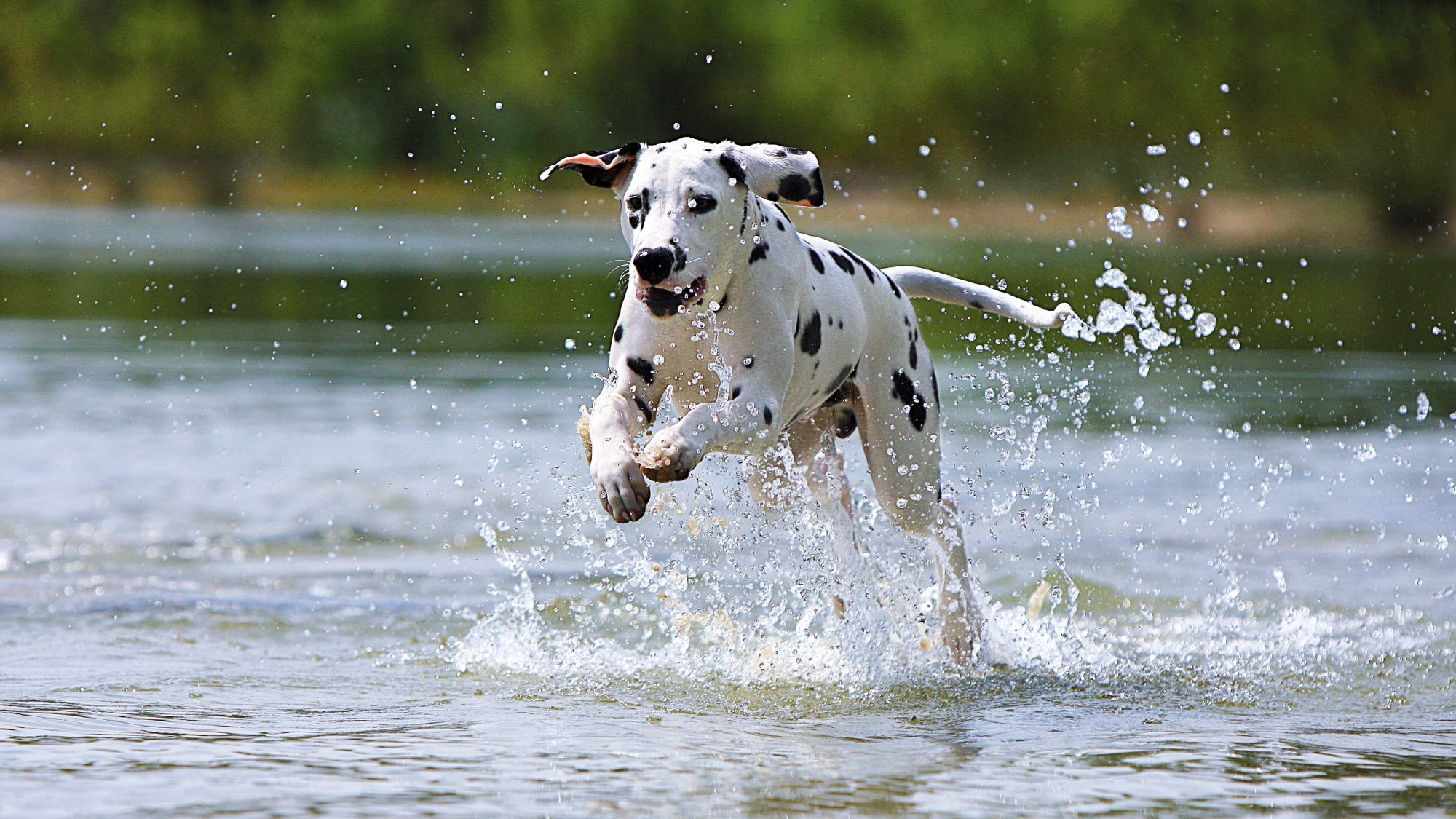
Get to know the Dalmatian
All you need to know about the breed
Immortalised in the animated Disney classic, 101 Dalmatians – how could we not mention it? – these beautiful animals make great canine companions. Energetic, affectionate and playful, Dalmatians have a lovely temperament and form close attachments to their human families. With their short, smooth coats, which come in either a black or liver colouring, they are also easy to take care of grooming-wise.
As accomplished sporting dogs, however, Dalmatians do need a decent amount of exercise each day. Got some well-worn running shoes? A Dalmation might just be your perfect jogging partner then. Long walks work too! In any event, with their athletic and muscular frames, the Dalmatian needs high levels of activity to keep them happy.
Originally thought to hail from Croatia, where they were used as hunting dogs, Dalmatians were later imported into Britain. There, they were utilised as coach dogs. It was here that the breed was also formally recognised, in 1890, with the creation of the first Dalmatian Club.
In another interesting chapter in their story, the Dalmatian went on to become synonymous with the fire service – especially in the US where they are an official mascot for the brigade to this day. Because of their background as coach-leading dogs, Dalmatians were used to guard the horses that would pull the fire carts. Even now, many firefighters choose to have a Dalmatian as a pet.
In more recent years, the Dalmatian experienced a huge spike in popularity thanks to their forays on the silver screen. As well as the 1961 Disney film, which was itself adapted from the novel of the same name by British author Dodie Smith, there were various other later spin-offs.
Sadly, though, this also meant that many Dalmatians ended up with inexperienced owners, who bought them for their children, with little idea of how to look after them. Thankfully, that situation has now abated – and, with the right care and plenty of exercise, Dalmatians are thriving in family homes across the world.
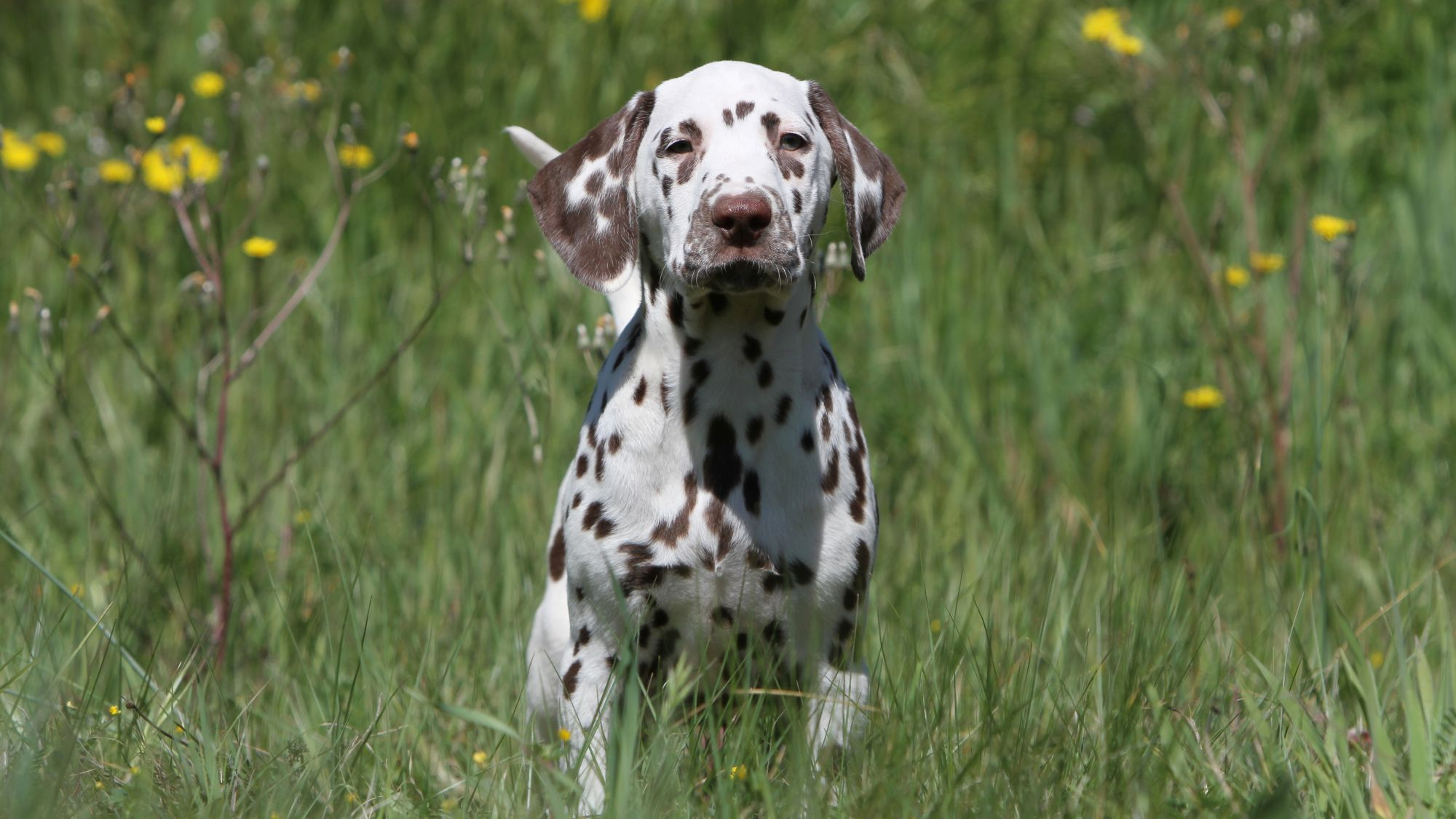
2 facts about Dalmatians
1. Spot the difference
Did you know that Dalmatian puppies are
born without any spots at all? They only start to get their distinctive
markings at around 10 days old. Their spots can continue to change shape until
around the time the Dalmatian becomes an adult.
2. The real 101 Dalmatians
Pongo, the Disney Dalmatian, actually
existed! He was one of nine dogs belonging to the British author, Dodie Smith,
who wrote the book that inspired the film. The novel itself, from 1956, is also
a great read for Dalmatian fans – or, indeed, dog-lovers of any kind.
History of the breed
Despite their latter-day stardom, the origins of the Dalmatian remain somewhat shrouded in mystery. While many claim they come from Dalmatia, in the Balkans, there is little evidence to support this theory. Nonetheless, it is generally agreed that they did come from Croatia originally and were later brought over to Britain.
What we do know for sure about the Dalmatian’s history is that, in the late 18th century, there was a type of white spotted dog known as the Talbot Hound. These animals were used to accompany horse-drawn coaches to guard the animals, the passengers and the goods. At night, they would also act as a watchdog for the stables. In 1791, the English author Thomas Bewick named this type of dog as ‘the Dalmatian’.
That said, they were known by a host of nicknames, too, ranging from the English Coach Dog to the Spotted Dick and the Plum Pudding Dog. The latter two were because the Dalmatian’s famous spots were thought to resemble the pieces of fruit in these popular British desserts.
During the 1800’s, the breed went on to become something of a status symbol among the nobility – while also being the favoured choice for Romani travellers. It was around this time that the Dalmatian’s long association with the fire service began, too. They were recognised by the American Kennel Club in 1888.
From head to tail
Physical characteristics of Dalmatians
1.Body
2.Tail
3.Head
4.Colouring
5.Coat
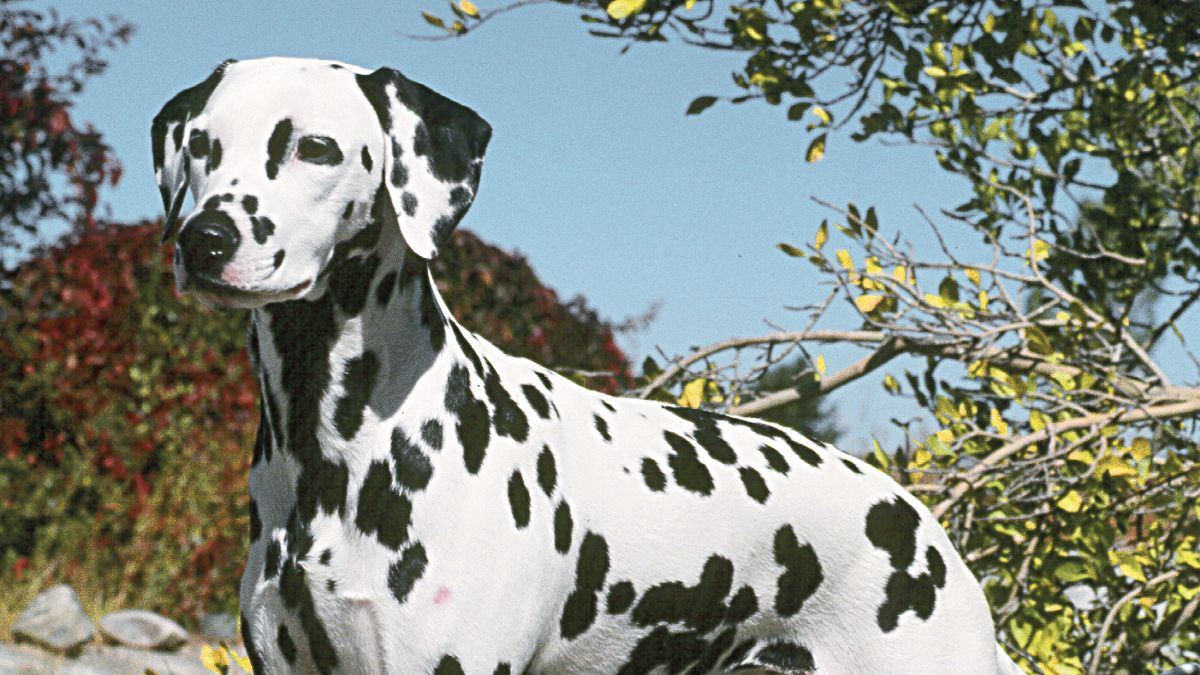
Things to look out for
From specific breed traits to a general health overview, here are some interesting facts about your Dalmatian
One possible yet common problem in Dalmatians: deafness
Sadly, more than 15% of dogs are affected to some degree – with prevalence as high as 30% in the US, according to some estimates. Around 5% are deaf in both ears. As well as the obvious risk of injury from accidents, it can also make it harder to train them, though certainly not impossible. In fact, because they are bright, they can easily learn sign language if their owner is willing to invent it. Linked to a gene in the Dalmatian’s piebald colouring, the condition is hereditary. However, reputable breeders will always check for hearing loss in the potential parents first, which can reduce the chance of it occurring in the litter, and the puppies themselves can be tested too. Thankfully, Dalmatians with only partial hearing loss can get by just fine and live a fairly normal life.
Another thing to watch out for is bladder or kidney stones
Although a typically healthy breed of dog, with a pretty good lifespan, Dalmatians can be prone to some complaints. One of these is a condition called hyperuricosuria – where elevated levels of uric acid in their urine can lead to the formation of bladder/kidney stones. However, the good news is that a carefully managed diet can go a long way towards prevention (see our ‘Healthy Diet, Healthier Dog’ section for more on feeding your Dalmatian). Also, if stones do develop, they can be removed through methods such as lithotripsy (ultrasonographic breaking of the stones). As a last resort, surgery is an option too. With the help of your vet, you can get a head start on possible treatments.
For their mental and physical well-being, Dalmatians need plenty of exercice
While all dogs require a certain level of daily activity, this is particularly important for the Dalmatian. With their sporty, agile bodies and working heritage, they thrive on outdoor physical exercise – and, as highly intelligent animals, they need the mental stimulation too. Kept confined for too long, this can lead to excess energy and, potentially, destructive behaviour in your Dalmatian. This, in turn, will lead to both an unhappy dog and owner. So, regular long walks – and ideally runs – are vital to their overall well-being. For more helpful facts on the Dalmatian’s exercise and training, check out the relevant sections below.
Healthy diet, healthier dog
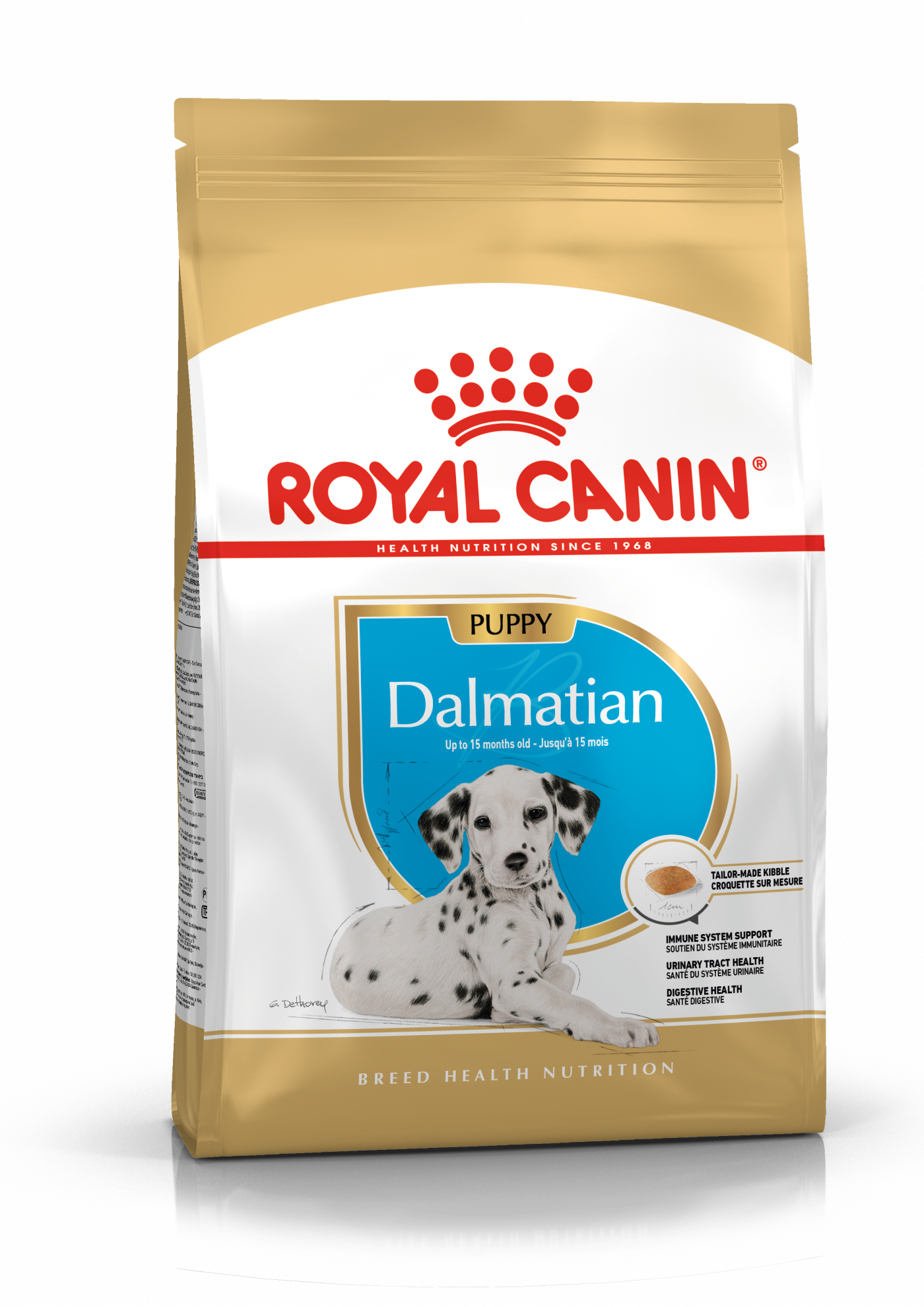
When choosing food for a Dalmatian, there are many factors to consider: their age, lifestyle, activity level, physiological condition, and health including potential sickness or sensitivities. Food provides energy to cover a dog’s vital functions, and a complete nutritional formula should contain an adjusted balance of nutrients to avoid any deficiency or excess in their diet, both of which could have adverse effects on the dog.
Clean and fresh water should be available at all times to support good urinary regularity. In hot weather and especially when out exercising, bring water along for your dog’s frequent water breaks.
Energy intake may also have to be adapted to the climatic conditions. A dog that lives outdoors in winter will have increased energy requirements.
The following recommendations are for healthy animals. If your dog has health problems, please consult your veterinarian who will prescribe an exclusive veterinary diet.
A Dalmatian puppy’s requirements, in terms of energy, protein, minerals, and vitamins, are much greater than those of an adult dog. They need energy and nutrients to maintain their body, but also to grow and build it. Until they are 15 months old, a Dalmatian puppies’ immune system develops gradually. A complex of antioxidants - including vitamin E - can help support their natural defences during this time of big changes, discoveries, and new encounters. Their digestive functions are different from an adult Dalmatian’s, too: their digestive system is not mature yet so it’s important to provide highly digestible proteins that will be effectively used. Prebiotics, such as fructo-oligosaccharides, support digestive health by helping balance the intestinal flora, resulting in good stool quality.
Similarly, a puppy’s teeth – starting with the milk teeth, or first teeth, then the permanent teeth – are an important factor that needs to be taken into account when choosing the size, shape, and texture of kibble. This long growth phase also means high energy needs, so the food must have a high energy content (expressed in Kcal/100g of food), while concentrations of all other nutrients will also be higher than normal in a specially formulated growth food. The Dalmatian is the only dog breed to excrete significant amounts of uric acid in its urine. This uric acid, which is the result of purine degradation, can result in the formation of urinary calculi, or stones, in some dogs. A food that has a low purine content, which helps limit uric acid excretion, is the best choice. Since urinary problems can appear as early as 12 months in Dalmatians, look for a diet with a carefully controlled level of purines to encourage good urinary system function. It is recommended to split the daily allowance into three meals until they are six months old, then to switch to two meals per day.
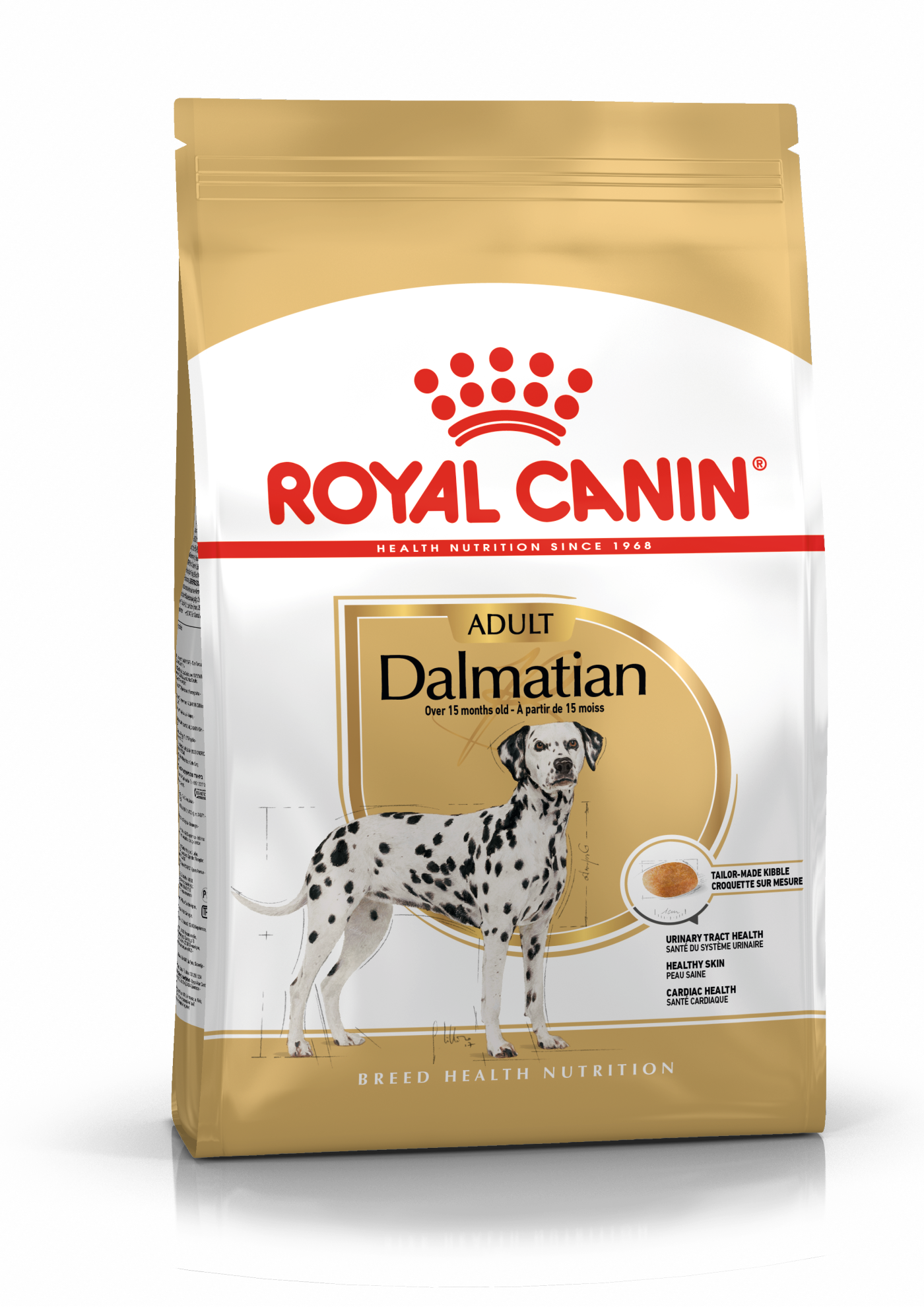
The main nutritional goals for adult Dalmatians are:
Maintaining urinary tract health by preventing urinary stones, by choosing selected protein sources with a low purine content
Helping to preserve the health and beauty of the skin and coat with the enriched provision of essential fatty acids (especially EPA-DHA), essential amino acids, and B vitamins. The Dalmatian’s stunning coat is a cover for their sensitive skin. These nutrients can help improve the skin’s defences against external pathogens and help slow down inflammatory reactions by reinforcing the skin’s “barrier” function.
Helping support good cardiac function with an adapted content of minerals, EPA-DHA, taurine, L-carnitine, and antioxidants
Supporting bones and joint health with glucosamine and chondroitin
Maintaining an ideal body weight by using highly digestible ingredients and keeping the fat content at a sensible level
Promoting optimal digestibility with high quality protein and a balanced supply of dietary fibre
To help support their natural defences, a formula enriched with an antioxidant complex and containing mannan-oligosaccharides is recommended.

After 7 years old, Dalmatians start facing the first signs of ageing. A formula enriched with antioxidants will help maintain their vitality. Ageing is also accompanied by the modification of digestive capacities and particular nutritional requirements, so food for older Dalmatians should have the following characteristics:
Higher vitamin C and E content. These nutrients have antioxidant properties, helping to protect the body’s cells against the harmful effects of the oxidative stress linked to ageing
Reduced phosphorus content to slow down the gradual deterioration of kidney function
A higher proportion of the trace elements iron, copper, zinc, and manganese to help maintain good condition of the skin and coat.
A higher quantity of polyunsaturated fatty acids (omega-3 and omega-6 fatty acids) to maintain the quality of the coat. Dogs can normally produce these fatty acids, but ageing can affect this physiological process.
As they age, dogs increasingly suffer from teeth problems. To ensure they continue to eat in sufficient quantities, the size, shape, and texture of their kibble need to be tailored to their jaw. An adapted kibble shape may help reduce the rate of food intake to help your dog maintain a healthy body weight.
Throughout their life, it is important to avoid feeding Dalmatians human foods or fatty snacks. Instead, reward them with kibble taken from their daily meal allowance, and strictly follow the feeding guidelines written on the package in order to prevent excessive weight gain.
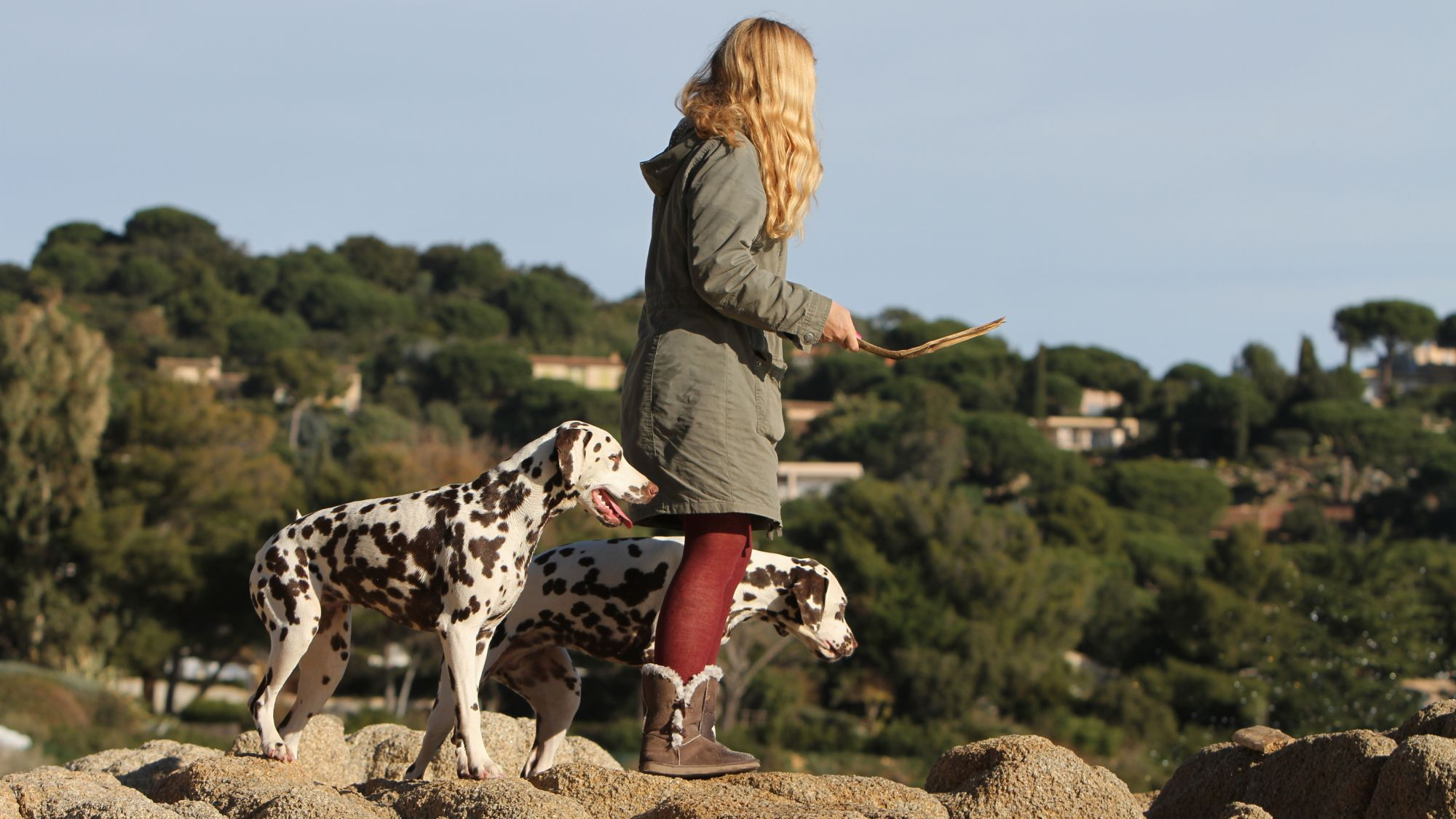
Caring for your Dalmatian
Grooming, training and exercise tips
If you’re wondering how much exercise a Dalmatian needs, they may not be the right dog for you – because the answer is a lot. Ideally, they should have one to three hours a day – or even more when possible. A Dalmatian that doesn’t get enough physical activity may well engage in destructive behaviour to get rid of their pent-up energy. With their background as hunting dogs, they like nothing better than tearing through the countryside – so, for anyone who enjoys hiking, running or even cycling, they make great exercise buddies. As the Dalmatian also has a playful streak, they respond well to games in the garden too.
Not only is the Dalmatian blessed with a beautiful coat, but their fur is relatively easy to maintain. A good brush once a week, with a rubber curry comb, is typically all it takes to keep them smooth and shiny and remove loose hairs. For the full Dalmatian grooming experience, the occasional bath is also recommended and their nails should be trimmed as often as necessary. Like all breeds, attention does need to be given to their dental hygiene. As well as daily teeth-brushing at home, they should have regular check-ups. Finally, the Dalmatian’s ears should also be monitored for any sign of debris or infection.
Both intelligent and eager to please, the Dalmatian’s personality traits make them a pleasure to train. However, as they are also quite sensitive animals, they respond best to positive, reward-based training. It’s best to get them into good habits from the start by taking your Dalmatian to puppy training. They will also benefit from this early socialisation as they can be suspicious of strangers and even a little shy. On the other hand, they can occasionally show signs of aggression around other dogs, so classes are a good idea all round. Even if they are hearing impaired, they can still be trained using hand signals or vibrating collars. Later, you may wish to continue your Dalmatian’s training with agility or obedience classes.
If you’re wondering how much exercise a Dalmatian needs, they may not be the right dog for you – because the answer is a lot. Ideally, they should have one to three hours a day – or even more when possible. A Dalmatian that doesn’t get enough physical activity may well engage in destructive behaviour to get rid of their pent-up energy. With their background as hunting dogs, they like nothing better than tearing through the countryside – so, for anyone who enjoys hiking, running or even cycling, they make great exercise buddies. As the Dalmatian also has a playful streak, they respond well to games in the garden too.
Not only is the Dalmatian blessed with a beautiful coat, but their fur is relatively easy to maintain. A good brush once a week, with a rubber curry comb, is typically all it takes to keep them smooth and shiny and remove loose hairs. For the full Dalmatian grooming experience, the occasional bath is also recommended and their nails should be trimmed as often as necessary. Like all breeds, attention does need to be given to their dental hygiene. As well as daily teeth-brushing at home, they should have regular check-ups. Finally, the Dalmatian’s ears should also be monitored for any sign of debris or infection.
Both intelligent and eager to please, the Dalmatian’s personality traits make them a pleasure to train. However, as they are also quite sensitive animals, they respond best to positive, reward-based training. It’s best to get them into good habits from the start by taking your Dalmatian to puppy training. They will also benefit from this early socialisation as they can be suspicious of strangers and even a little shy. On the other hand, they can occasionally show signs of aggression around other dogs, so classes are a good idea all round. Even if they are hearing impaired, they can still be trained using hand signals or vibrating collars. Later, you may wish to continue your Dalmatian’s training with agility or obedience classes.
7/7
All about Dalmatians
As a rule, Dalmatians are generally
very docile as a breed and rarely show
signs of aggression. However, they can be a little reserved with strangers
and will occasionally assert their dominance over other dogs. As they are
also very energetic and playful animals, Dalmatians will do better in a
household without small children around.
It depends very much on the lifestyle that
you have. If you like walking and/or jogging, you and your Dalmatian will
get along just fine. If, however, you are more of a homebody, you may be better
off having a smaller-size dog (the
full-grown Dalmatian can reach around 24 inches or 61cm) that also has lower
energy levels.
Other breeds that might interest you
Read more on this topic
Sources
- Veterinary Centers of America https://vcahospitals.com/
- Royal Canin Dog Encyclopaedia. Ed 2010 and 2020
- Banfield Pet Hospital https://www.banfield.com/
- Royal Canin BHN Product Book
- American Kennel Club https://www.akc.org/
Like & share this page